| 编辑推荐: |
本文主要介绍如何通过环境的安装以及插件的安装及使用来搭建ELK日志分析系统,直至最终的上线,希望对您的学习有所帮助。
本文来自于博客园,由火龙果软件Alice编辑、推荐。 |
|
一、ELK搭建篇
官网地址
官网权威指南
安装指南
ELK是Elasticsearch、Logstash、Kibana的简称,这三者是核心套件,但并非全部。
Elasticsearch是实时全文搜索和分析引擎,提供搜集、分析、存储数据三大功能;是一套开放REST和JAVA
API等结构提供高效搜索功能,可扩展的分布式系统。它构建于Apache Lucene搜索引擎库之上。
Logstash是一个用来搜集、分析、过滤日志的工具。它支持几乎任何类型的日志,包括系统日志、错误日志和自定义应用程序日志。它可以从许多来源接收日志,这些来源包括
syslog、消息传递(例如 RabbitMQ)和JMX,它能够以多种方式输出数据,包括电子邮件、websockets和Elasticsearch。
Kibana是一个基于Web的图形界面,用于搜索、分析和可视化存储在 Elasticsearch指标中的日志数据。它利用Elasticsearch的REST接口来检索数据,不仅允许用户创建他们自己的数据的定制仪表板视图,还允许他们以特殊的方式查询和过滤数据

环境
Centos6.5 两台
IP:192.168.1.202 安装: elasticsearch、logstash、Kibana、Nginx、Http、Redis
192.168.1.201 安装: logstash |
安装
安装elasticsearch的yum源的密钥(这个需要在所有服务器上都配置)
# rpm --import https://artifacts.elastic.co/GPG-KEY-elasticsearch
配置elasticsearch的yum源
# vim /etc/yum.repos.d/elasticsearch.repo
在elasticsearch.repo文件中添加如下内容
[elasticsearch-5.x]
name=Elasticsearch repository for 5.x packages
baseurl=https://artifacts.elastic.co/packages/5.x/yum
gpgcheck=1
gpgkey=https://artifacts.elastic.co/GPG-KEY-elasticsearch
enabled=1
autorefresh=1
type=rpm-md |
安装elasticsearch的环境
安装elasticsearch
# yum install -y elasticsearch
安装java环境(java环境必须是1.8版本以上的)
wget http://download.oracle.com/otn-pub/java/jdk/8u131-b11/d54c1d3a095b4ff2b6607d096fa80163/jdk-8u131-linux-x64.rpm
rpm -ivh jdk-8u131-linux-x64.rpm
验证java安装成功
java -version
java version "1.8.0_131"
Java(TM) SE Runtime Environment (build 1.8.0_131-b11)
Java HotSpot(TM) 64-Bit Server VM (build 25.131-b11,
mixed mode) |
创建elasticsearch data的存放目录,并修改该目录的属主属组
# mkdir -p /data/es-data
(自定义用于存放data数据的目录)
# chown -R elasticsearch:elasticsearch /data/es-data |
修改elasticsearch的日志属主属组
| # chown -R elasticsearch:elasticsearch
/var/log/elasticsearch/ |
修改elasticsearch的配置文件
# vim /etc/elasticsearch/elasticsearch.yml
找到配置文件中的cluster.name,打开该配置并设置
集群名称cluster.name: demon
找到配置文件中的node.name,打开该配置并设置
节点名称
node.name: elk-1
修改data存放的路径
path.data: /data/es-data
修改logs日志的路径
path.logs: /var/log/elasticsearch/
配置内存使用用交换分区
bootstrap.memory_lock: true
监听的网络地址
network.host: 0.0.0.0
开启监听的端口
http.port: 9200
增加新的参数,这样head插件可以访问es (5.x版本,
如果没有可以自己手动加)
http.cors.enabled: true
http.cors.allow-origin: "*"
启动elasticsearch服务 |
启动服务
/etc/init.d/elasticsearch
start
Starting elasticsearch: Java HotSpot(TM) 64-Bit
Server VM warning: INFO: os::commit_memory(0x0000000085330000,
2060255232, 0) failed; error='Cannot allocate
memory' (errno=12)
#
# There is insufficient memory for the Java
Runtime Environment to continue.
# Native memory allocation (mmap) failed to
map 2060255232 bytes for committing reserved
memory.
# An error report file with more information
is saved as:
# /tmp/hs_err_pid2616.log
[FAILED]
这个报错是因为默认使用的内存大小为2G,虚拟机没
有那么多的空间修改参数:
vim /etc/elasticsearch/jvm.options
-Xms512m
-Xmx512m
再次启动
/etc/init.d/elasticsearch start
查看服务状态,如果有报错可以去看错误日志 less /var/log/elasticsearch/demon.log(日志的名称是
以集群名称命名的)
创建开机自启动服务
# chkconfig elasticsearch on |
注意事项
需要修改几个参数,不然启动会报错
vim /etc/security/limits.conf
在末尾追加以下内容(elk为启动用户,当然也可以指定为*)
elk soft nofile 65536
elk hard nofile 65536
elk soft nproc 2048
elk hard nproc 2048
elk soft memlock unlimited
elk hard memlock unlimited
继续再修改一个参数
vim /etc/security/limits.d/90-nproc.conf
将里面的1024改为2048(ES最少要求为2048)
* soft nproc 2048
另外还需注意一个问题(在日志发现如下内容,
这样也会导致启动失败,这一问题困扰了很久)
[2017-06-14T19:19:01,641][INFO ][o.e.b.Bootstrap
Checks
] [elk-1] bound or publishing to a non-loopback
or non-link-local address, enforcing bootstrap
checks
[2017-06-14T19:19:01,658][ERROR][o.e.b.Bootstrap
]
[elk-1] node validation exception
[1] bootstrap checks failed
[1]: system call filters failed to install;
check the logs and fix your configuration or
disable system call filters at your own risk
解决:修改配置文件,在配置文件添加一项参数
(目前还没明白此参数的作用)
vim /etc/elasticsearch/elasticsearch.yml
bootstrap.system_call_filter: false |
通过浏览器请求下9200的端口,看下是否成功
先检查9200端口是否起来
netstat -antp |grep 9200
tcp 0 0 :::9200 :::* LISTEN 2934/java
浏览器访问测试是否正常(以下为正常)
# curl http://127.0.0.1:9200/
{
"name" : "linux-node1",
"cluster_name" : "demon",
"cluster_uuid" : "kM0GMFrsQ8K_cl5Fn7BF-g",
"version" : {
"number" : "5.4.0",
"build_hash" : "780f8c4",
"build_date" : "2017-04-28T17:43:27.229Z",
"build_snapshot" : false,
"lucene_version" : "6.5.0"
},
"tagline" : "You Know, for Search"
} |
如何和elasticsearch交互
JavaAPI
RESTful API
Javascript,.Net,PHP,Perl,Python
利用API查看状态
# curl -i -XGET 'localhost:9200/_count?pretty'
HTTP/1.1 200 OK
content-type: application/json; charset=UTF-8
content-length: 95
{
"count" : 0,
"_shards" : {
"total" : 0,
"successful" : 0,
"failed" : 0
}
} |
安装插件
安装elasticsearch-head插件
安装docker镜像或者通过github下载elasticsearch-head项目都是可以的,1或者2两种方式选择一种安装使用即可
1. 使用docker的集成好的elasticsearch-head
# docker run -p 9100:9100 mobz/elasticsearch-head:5
docker容器下载成功并启动以后,运行浏览器打开http://localhost:9100/
2. 使用git安装elasticsearch-head
# yum install -y npm
# git clone git://github.com/mobz/elasticsearch-head.git
# cd elasticsearch-head
# npm install
# npm run start
检查端口是否起来
netstat -antp |grep 9100
浏览器访问测试是否正常
http://IP:9100/ |
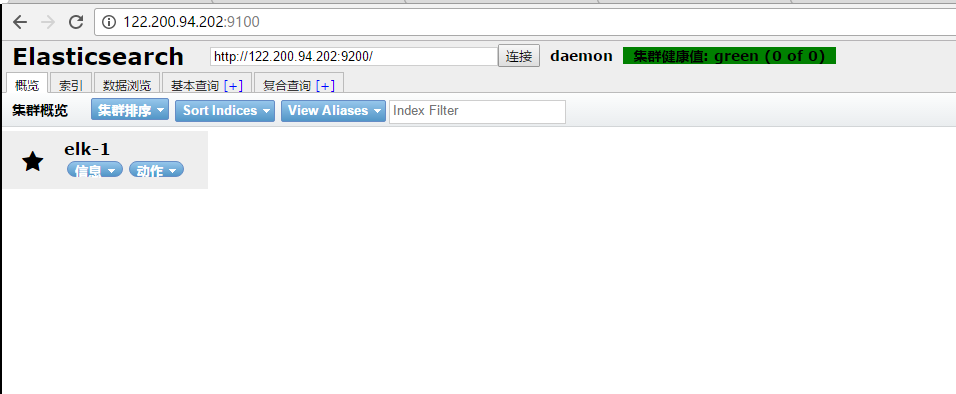
LogStash的使用
安装Logstash环境:
官方安装手册:
https://www.elastic.co/guide/en/logstash/current
/installing-logstash.html
下载yum源的密钥认证:
# rpm --import https://artifacts.elastic.co/GPG-KEY-elasticsearch
利用yum安装logstash
# yum install -y logstash
查看下logstash的安装目录
# rpm -ql logstash
创建一个软连接,每次执行命令的时候不用在写安装路劲(默认安装在/usr/share下)
ln -s /usr/share/logstash/bin/logstash /bin/
执行logstash的命令
# logstash -e 'input { stdin { } } output {
stdout {} }'
运行成功以后输入:
nihao
stdout返回的结果: |

注:
-e 执行操作
input 标准输入
{ input } 插件
output 标准输出
{ stdout } 插件
通过rubydebug来输出下更详细的信息
# logstash -e 'input { stdin { } } output {
stdout {codec => rubydebug} }'
执行成功输入:
nihao
stdout输出的结果: |

如果标准输出还有elasticsearch中都需要保留应该怎么玩,看下面
如果标准输出还有elasticsearch中都需要保留应该怎么玩,看下面
# /usr/share/logstash/bin/logstash -e 'input {
stdin { } } output { elasticsearch { hosts =>
["192.168.1.202:9200"] } stdout { codec
=> rubydebug }}'
运行成功以后输入:
I am elk
返回的结果(标准输出中的结果): |
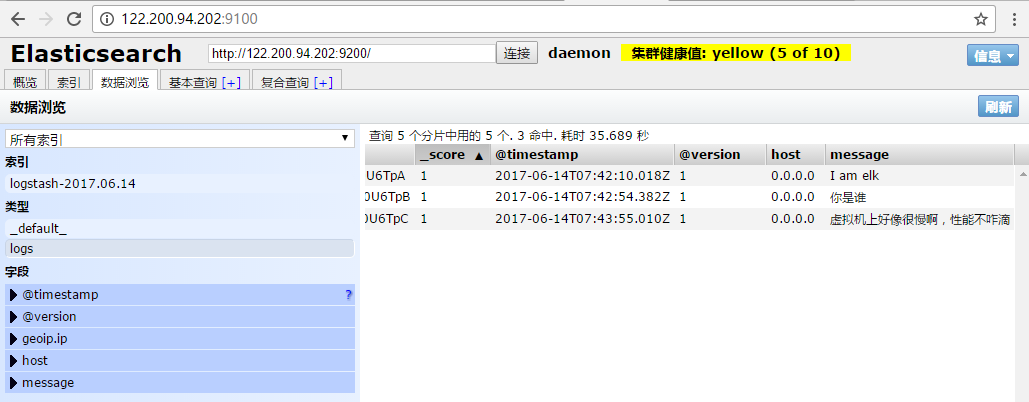
logstash使用配置文件
官方指南:
https://www.elastic.co/guide/en/logstash/current/
configuration.html
创建配置文件01-logstash.conf
# vim /etc/logstash/conf.d/elk.conf
文件中添加以下内容
input { stdin { } }
output {
elasticsearch { hosts => ["192.168.1.202:9200"]
}
stdout { codec => rubydebug }
}
使用配置文件运行logstash
# logstash -f ./elk.conf
运行成功以后输入以及标准输出结果 |

logstash的数据库类型
1. Input插件
权威指南:https://www.elastic.co/guide/en/logstash/
current/input-plugins.html
file插件的使用
# vim /etc/logstash/conf.d/elk.conf
添加如下配置
input {
file {
path => "/var/log/messages"
type => "system"
start_position => "beginning"
}
}
output {
elasticsearch {
hosts => ["192.168.1.202:9200"]
index => "system-%{+YYYY.MM.dd}"
}
}
运行logstash指定elk.conf配置文件,进行过滤匹配
#logstash -f /etc/logstash/conf.d/elk.conf
|

来一发配置安全日志的并且把日志的索引按类型做存放,继续编辑elk.conf文件
# vim /etc/logstash/conf.d/elk.conf
添加secure日志的路径
input {
file {
path => "/var/log/messages"
type => "system"
start_position => "beginning"
}
file {
path => "/var/log/secure"
type => "secure"
start_position => "beginning"
}
}
output {
if [type] == "system" {
elasticsearch {
hosts => ["192.168.1.202:9200"]
index => "nagios-system-%{+YYYY.MM.dd}"
}
}
if [type] == "secure" {
elasticsearch {
hosts => ["192.168.1.202:9200"]
index => "nagios-secure-%{+YYYY.MM.dd}"
}
}
}
运行logstash指定elk.conf配置文件,进行过滤匹配
# logstash -f ./elk.conf
|
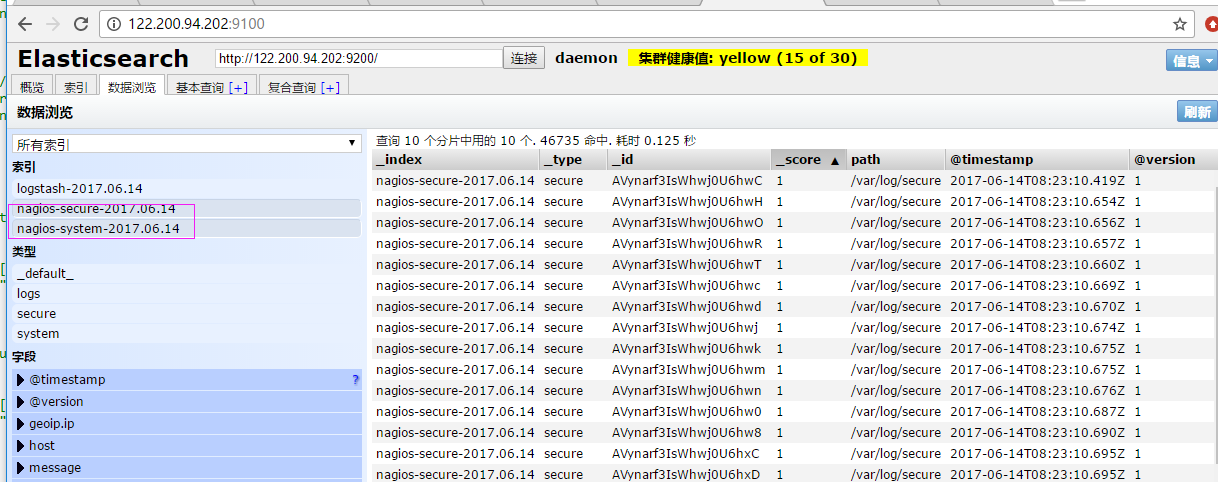
这些设置都没有问题之后,接下来安装下kibana,可以让在前台展示
Kibana的安装及使用
安装kibana环境
官方安装手册:https://www.elastic.co/guide/en/kibana
/current/install.html
下载kibana的tar.gz的软件包
# wget https://artifacts.elastic.co/downloads/kibana
/kibana-5.4.0-linux-x86_64.tar.gz
解压kibana的tar包
# tar -xzf kibana-5.4.0-linux-x86_64.tar.gz
进入解压好的kibana
# mv kibana-5.4.0-linux-x86_64 /usr/local
创建kibana的软连接
# ln -s /usr/local/kibana-5.4.0-linux-x86_64/
/usr/local/kibana
编辑kibana的配置文件
# vim /usr/local/kibana/config/kibana.yml
修改配置文件如下,开启以下的配置
server.port: 5601
server.host: "0.0.0.0"
elasticsearch.url: "http://192.168.1.202:9200"
kibana.index: ".kibana"
安装screen,以便于kibana在后台运行(当然也可以不
用安装,用其他方式进行后台启动)
# yum -y install screen
# screen
# /usr/local/kibana/bin/kibana
netstat -antp |grep 5601
tcp 0 0 0.0.0.0:5601 0.0.0.0:* LISTEN 17007/node
打开浏览器并设置对应的index
http://IP:5601 |
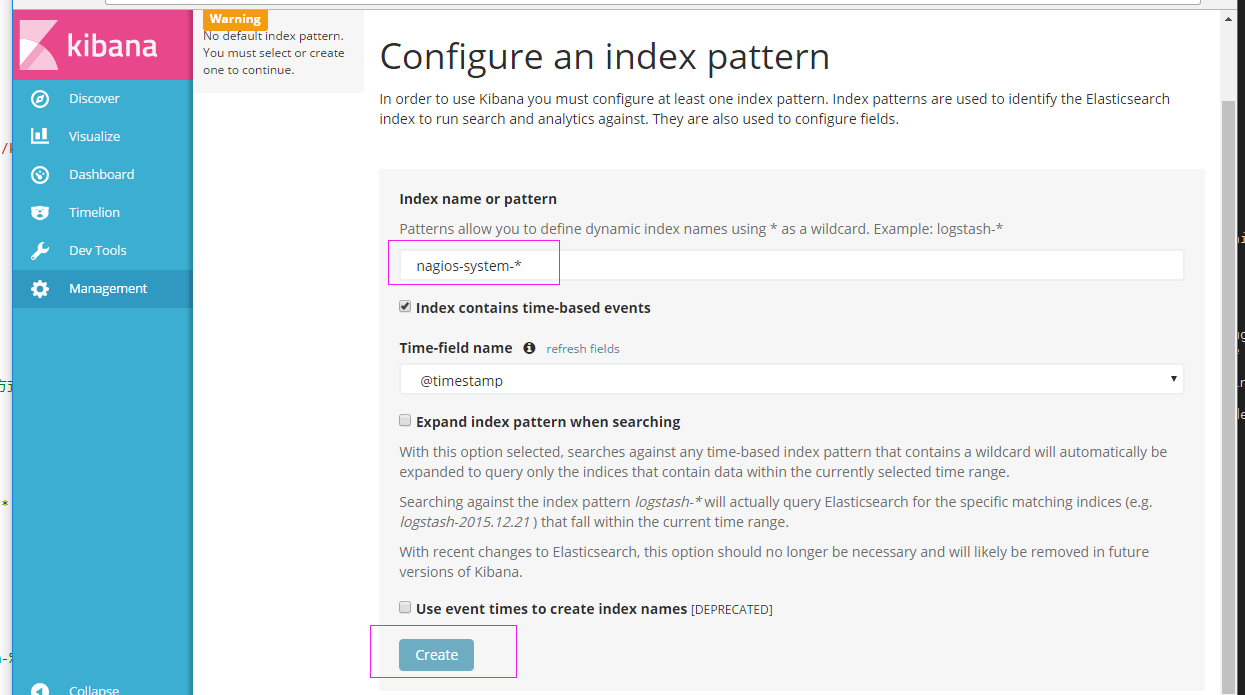
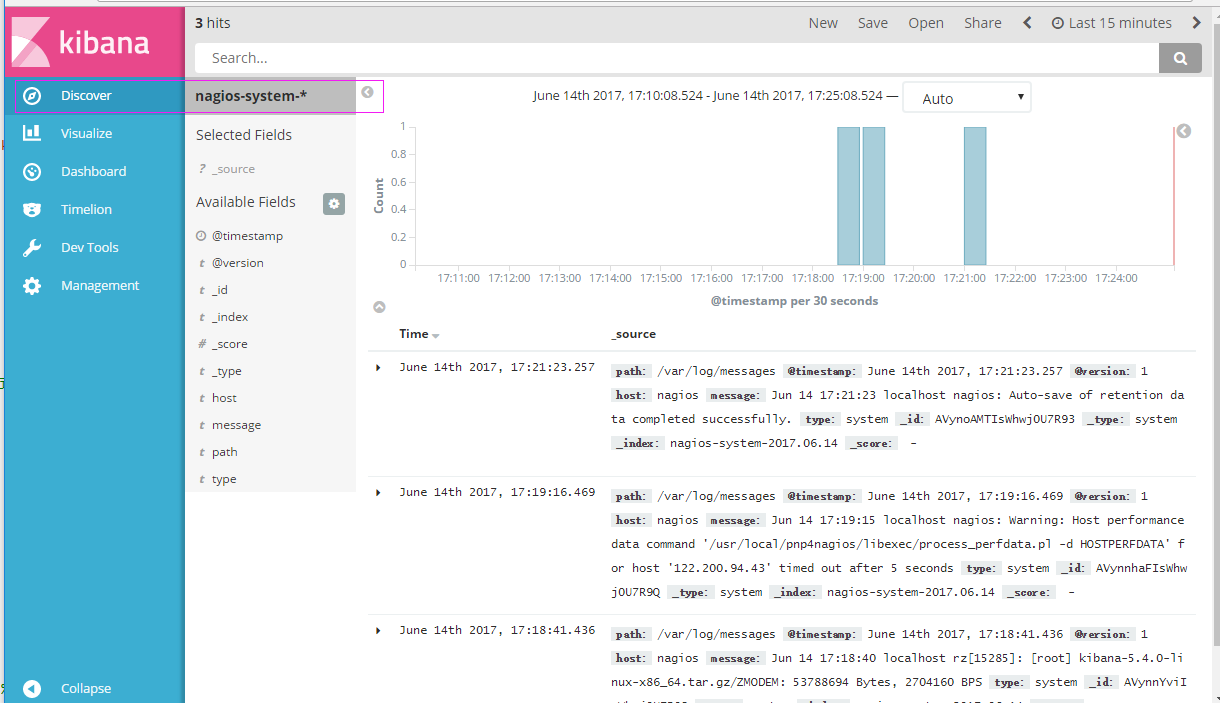
二、ELK实战篇
好,现在索引也可以创建了,现在可以来输出nginx、apache、message、secrue的日志到前台展示(Nginx有的话直接修改,没有自行安装)
编辑nginx配置文件,修改以下内容(在http模块下添加)
log_format json '{"@timestamp":"$time_iso8601",'
'"@version":"1",'
'"client":"$remote_addr",'
'"url":"$uri",'
'"status":"$status",'
'"domian":"$host",'
'"host":"$server_addr",'
'"size":"$body_bytes_sent",'
'"responsetime":"$request_time",'
'"referer":"$http_referer",'
'"ua":"$http_user_agent"'
'}';
修改access_log的输出格式为刚才定义的json
access_log logs/elk.access.log json;
继续修改apache的配置文件
LogFormat "{ \
\"@timestamp\": \"%{%Y-%m-%dT%H:%M:%S%z}t\",
\
\"@version\": \"1\", \
\"tags\":[\"apache\"], \
\"message\": \"%h %l %u %t \\\"%r\\\"
%>s %b\", \
\"clientip\": \"%a\", \
\"duration\": %D, \
\"status\": %>s, \
\"request\": \"%U%q\", \
\"urlpath\": \"%U\", \
\"urlquery\": \"%q\", \
\"bytes\": %B, \
\"method\": \"%m\", \
\"site\": \"%{Host}i\",
\
\"referer\": \"%{Referer}i\",
\
\"useragent\": \"%{User-agent}i\"
\
}" ls_apache_json
一样修改输出格式为上面定义的json格式
CustomLog logs/access_log ls_apache_json
编辑logstash配置文件,进行日志收集
vim /etc/logstash/conf.d/full.conf
input {
file {
path => "/var/log/messages"
type => "system"
start_position => "beginning"
}
file {
path => "/var/log/secure"
type => "secure"
start_position => "beginning"
}
file {
path => "/var/log/httpd/access_log"
type => "http"
start_position => "beginning"
}
file {
path => "/usr/local/nginx/logs/elk.access.log"
type => "nginx"
start_position => "beginning"
}
}
output {
if [type] == "system" {
elasticsearch {
hosts => ["192.168.1.202:9200"]
index => "nagios-system-%{+YYYY.MM.dd}"
}
}
if [type] == "secure" {
elasticsearch {
hosts => ["192.168.1.202:9200"]
index => "nagios-secure-%{+YYYY.MM.dd}"
}
}
if [type] == "http" {
elasticsearch {
hosts => ["192.168.1.202:9200"]
index => "nagios-http-%{+YYYY.MM.dd}"
}
}
if [type] == "nginx" {
elasticsearch {
hosts => ["192.168.1.202:9200"]
index => "nagios-nginx-%{+YYYY.MM.dd}"
}
}
}
运行看看效果如何
logstash -f /etc/logstash/conf.d/full.conf |

可以发现所有创建日志的索引都已存在,接下来就去Kibana创建日志索引,进行展示(按照上面的方法进行创建索引即可),看下展示的效果
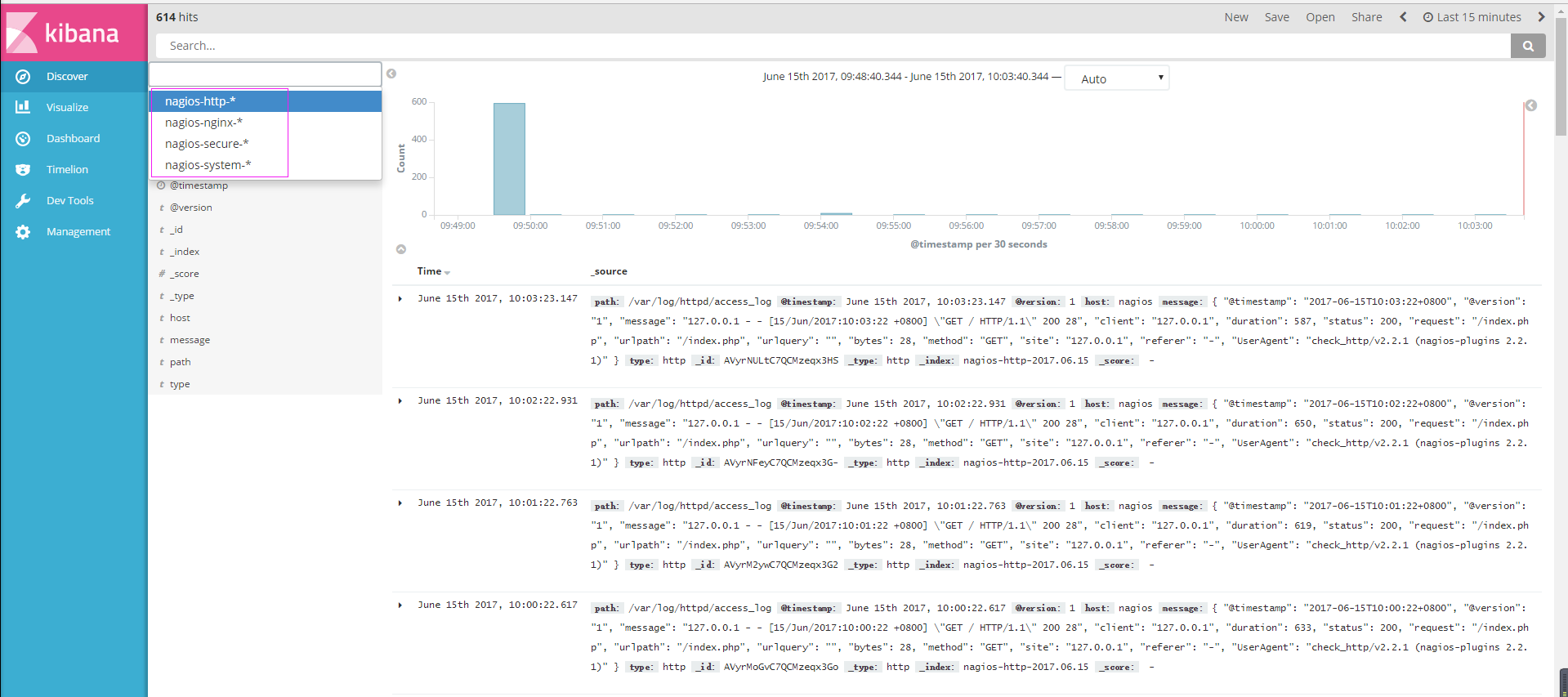
接下来再来一发MySQL慢日志的展示
由于MySQL的慢日志查询格式比较特殊,所以需要用正则进行匹配,并使用multiline能够进行多行匹配(看具体配置)
input {
file {
path => "/var/log/messages"
type => "system"
start_position => "beginning"
}
file {
path => "/var/log/secure"
type => "secure"
start_position => "beginning"
}
file {
path => "/var/log/httpd/access_log"
type => "http"
start_position => "beginning"
}
file {
path => "/usr/local/nginx/logs/elk.access.log"
type => "nginx"
start_position => "beginning"
}
file {
path => "/var/log/mysql/mysql.slow.log"
type => "mysql"
start_position => "beginning"
codec => multiline {
pattern => "^# User@Host:"
negate => true
what => "previous"
}
}
}
filter {
grok {
match => { "message" => "SELECT
SLEEP" }
add_tag => [ "sleep_drop" ]
tag_on_failure => []
}
if "sleep_drop" in [tags] {
drop {}
}
grok {
match => { "message" => "(?m)^#
User@Host: %{USER:User}
\[[^\]]+\] @ (?:(?<clienthost>\S*)
)?\[(?:%{IP:
Client_IP})?\]\s.*# Query_time:
%{NUMBER:Query_Time:float}\s+Lock_time: %{NUMBER:Lock_Time:float}\s+Rows_sent:
%{NUMBER:Rows_Sent:int}\s+Rows_examined: %{NUMBER:Rows_Examined:int}\s*(?:use
%{DATA:Database}
;\s*)?SET timestamp=%{NUMBER:timestamp};\s*(?<Query>
(?<Action>
\w+)\s+.*)\n#
Time:.*$" }
}
date {
match => [ "timestamp", "UNIX"
]
remove_field => [ "timestamp" ]
}
}
output {
if [type] == "system" {
elasticsearch {
hosts => ["192.168.1.202:9200"]
index => "nagios-system-%{+YYYY.MM.dd}"
}
}
if [type] == "secure" {
elasticsearch {
hosts => ["192.168.1.202:9200"]
index => "nagios-secure-%{+YYYY.MM.dd}"
}
}
if [type] == "http" {
elasticsearch {
hosts => ["192.168.1.202:9200"]
index => "nagios-http-%{+YYYY.MM.dd}"
}
}
if [type] == "nginx" {
elasticsearch {
hosts => ["192.168.1.202:9200"]
index => "nagios-nginx-%{+YYYY.MM.dd}"
}
}
if [type] == "mysql" {
elasticsearch {
hosts => ["192.168.1.202:9200"]
index => "nagios-mysql-slow-%{+YYYY.MM.dd}"
}
}
} |
查看效果(一条慢日志查询会显示一条,如果不进行正则匹配,那么一行就会显示一条)
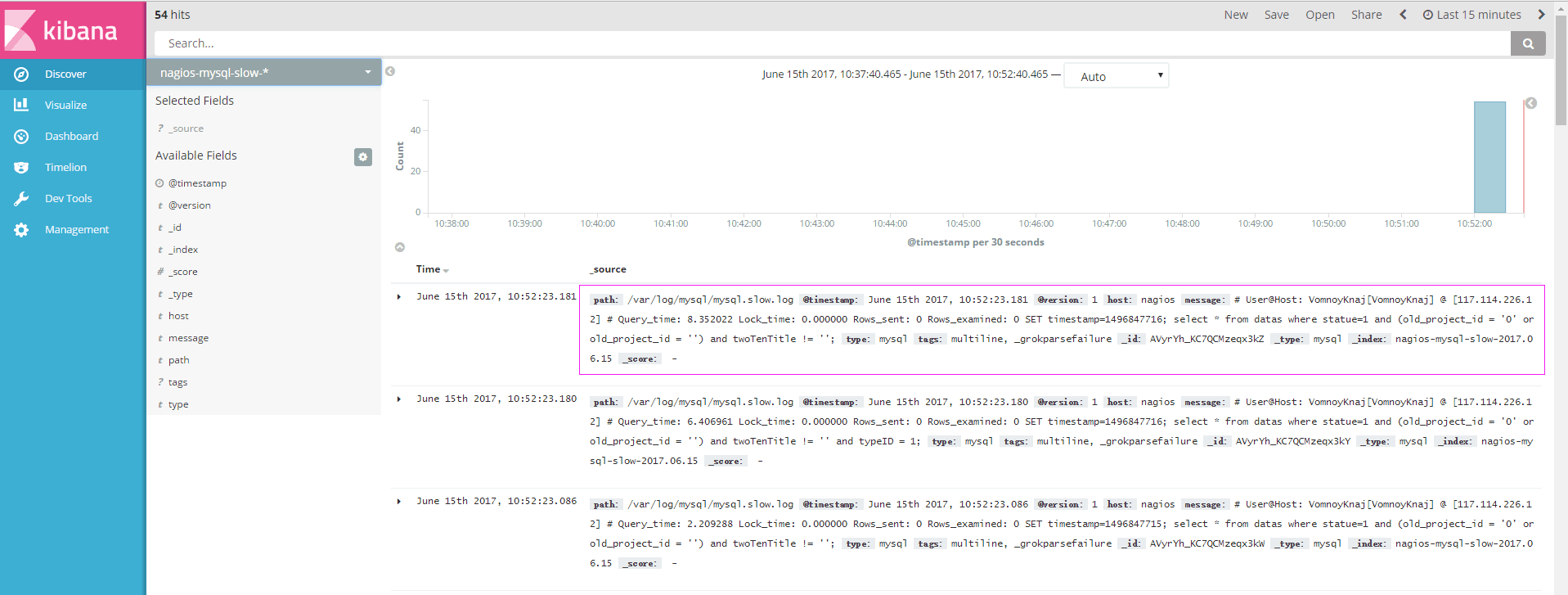
具体的日志输出需求,进行具体的分析
三:ELK终极篇
安装reids
# yum install -y redis
修改redis的配置文件
# vim /etc/redis.conf
修改内容如下
daemonize yes
bind 192.168.1.202
启动redis服务
# /etc/init.d/redis restart
测试redis的是否启用成功
# redis-cli -h 192.168.1.202
输入info如果有不报错即可
redis 192.168.1.202:6379> info
redis_version:2.4.10
....
编辑配置redis-out.conf配置文件,把标准输入的数据存储到redis中
# vim /etc/logstash/conf.d/redis-out.conf
添加如下内容
input {
stdin {}
}
output {
redis {
host => "192.168.1.202"
port => "6379"
password => 'test'
db => '1'
data_type => "list"
key => 'elk-test'
}
}
运行logstash指定redis-out.conf的配置文件
# /usr/share/logstash/bin/logstash -f /etc/logstash/conf.d/redis-out.conf |
运行成功以后,在logstash中输入内容(查看下效果)
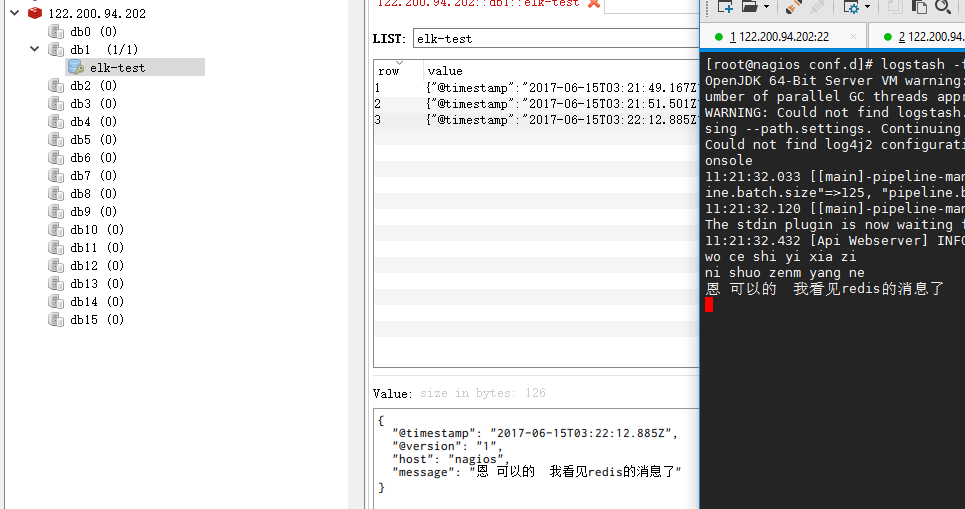
编辑配置redis-in.conf配置文件,把reids的存储的数据输出到elasticsearch中
# vim /etc/logstash/conf.d/redis-out.conf
添加如下内容
input{
redis {
host => "192.168.1.202"
port => "6379"
password => 'test'
db => '1'
data_type => "list"
key => 'elk-test'
batch_count => 1 #这个值是指从队列中读取数据时,一次性取出多少条,默认125条(如果redis中没有125条,就会报错,所以在测试期间加上这个值)
}
}
output {
elasticsearch {
hosts => ['192.168.1.202:9200']
index => 'redis-test-%{+YYYY.MM.dd}'
}
}
运行logstash指定redis-in.conf的配置文件
# /usr/share/logstash/bin/logstash -f /etc/logstash/conf.d/redis-out.conf |

把之前的配置文件修改一下,变成所有的日志监控的来源文件都存放到redis中,然后通过redis在输出到elasticsearch中
更改为如下,编辑full.conf
input {
file {
path => "/var/log/httpd/access_log"
type => "http"
start_position => "beginning"
}
file {
path => "/usr/local/nginx/logs/elk.access.log"
type => "nginx"
start_position => "beginning"
}
file {
path => "/var/log/secure"
type => "secure"
start_position => "beginning"
}
file {
path => "/var/log/messages"
type => "system"
start_position => "beginning"
}
}
output {
if [type] == "http" {
redis {
host => "192.168.1.202"
password => 'test'
port => "6379"
db => "6"
data_type => "list"
key => 'nagios_http'
}
}
if [type] == "nginx" {
redis {
host => "192.168.1.202"
password => 'test'
port => "6379"
db => "6"
data_type => "list"
key => 'nagios_nginx'
}
}
if [type] == "secure" {
redis {
host => "192.168.1.202"
password => 'test'
port => "6379"
db => "6"
data_type => "list"
key => 'nagios_secure'
}
}
if [type] == "system" {
redis {
host => "192.168.1.202"
password => 'test'
port => "6379"
db => "6"
data_type => "list"
key => 'nagios_system'
}
}
}
运行logstash指定shipper.conf的配置文件
# /usr/share/logstash/bin/logstash -f /etc/logstash/conf.d/full.conf
|
在redis中查看是否已经将数据写到里面(有时候输入的日志文件不产生日志,会导致redis里面也没有写入日志)
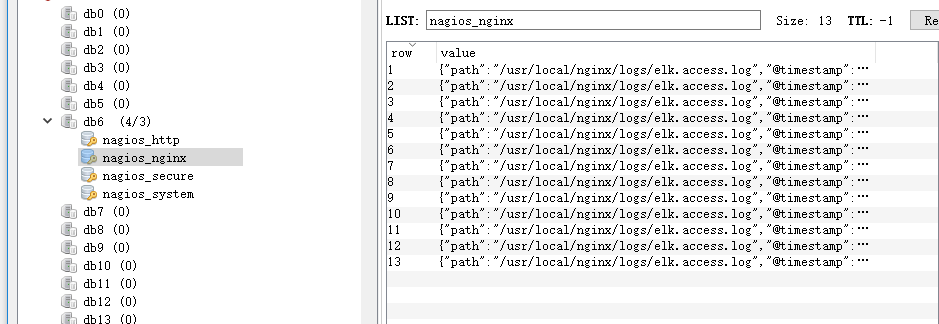
把redis中的数据读取出来,写入到elasticsearch中(需要另外一台主机做实验)
编辑配置文件
# vim /etc/logstash/conf.d/redis-out.conf
添加如下内容
input {
redis {
type => "system"
host => "192.168.1.202"
password => 'test'
port => "6379"
db => "6"
data_type => "list"
key => 'nagios_system'
batch_count => 1
}
redis {
type => "http"
host => "192.168.1.202"
password => 'test'
port => "6379"
db => "6"
data_type => "list"
key => 'nagios_http'
batch_count => 1
}
redis {
type => "nginx"
host => "192.168.1.202"
password => 'test'
port => "6379"
db => "6"
data_type => "list"
key => 'nagios_nginx'
batch_count => 1
}
redis {
type => "secure"
host => "192.168.1.202"
password => 'test'
port => "6379"
db => "6"
data_type => "list"
key => 'nagios_secure'
batch_count => 1
}
}
output {
if [type] == "system" {
elasticsearch {
hosts => ["192.168.1.202:9200"]
index => "nagios-system-%{+YYYY.MM.dd}"
}
}
if [type] == "http" {
elasticsearch {
hosts => ["192.168.1.202:9200"]
index => "nagios-http-%{+YYYY.MM.dd}"
}
}
if [type] == "nginx" {
elasticsearch {
hosts => ["192.168.1.202:9200"]
index => "nagios-nginx-%{+YYYY.MM.dd}"
}
}
if [type] == "secure" {
elasticsearch {
hosts => ["192.168.1.202:9200"]
index => "nagios-secure-%{+YYYY.MM.dd}"
}
}
} |
注意:
input是从客户端收集的
output是同样也保存到192.168.1.202中的elasticsearch中,如果要保存到当前的主机上,可以把output中的hosts修改成localhost,如果还需要在kibana中显示,需要在本机上部署kabana,为何要这样做,起到一个松耦合的目的
说白了,就是在客户端收集日志,写到服务端的redis里或是本地的redis里面,输出的时候对接ES服务器即可
运行命令看看效果
| # /usr/share/logstash/bin/logstash
-f /etc/logstash/conf.d/redis-out.conf |
效果是和直接往ES服务器输出一样的(这样是先将日志存到redis数据库,然后再从redis数据库里取出日志)

上线ELK

因为ES保存日志是永久保存,所以需要定期删除一下日志,下面命令为删除指定时间前的日志
curl -X DELETE
http://xx.xx.com:9200/
logstash-*-`date +%Y-%m-%d
-d "-$n days"` |
|